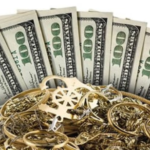
Selling gold never has been simpler – or more dangerous. With costs of the valuable metal hitting records practically day by day ($1,774 the ounce, starting today), and with dread and vulnerability proceeding to annoy the world’s budgetary markets, gold purchasers are anxious to pay as much as possible for any gems, coins or bars you want to part with.
Never have there been such a large number of decisions on where and how to sell. In Texas, you can get a pleasant steak for supper and dump your tiara simultaneously: Gold and Silver Buyers, the state’s greatest purchaser of valuable metals, has its stores strategically placed inside or nearby general stores.
Since May, eBay has been offering another component on its site- – a Bullion Center. Representative Johnna Hoff says it was made “to be a one-stop goal” solidifying exchange a wide range of bullion- – gold and silver coins and bars, fundamentally. The terms and conditions that apply to the closeout of a gold bar are not any more difficult those that apply to someone who sells a toaster, a football pullover, or whatever else on eBay: Small, easygoing dealers (non-experts) pay eBay 9 percent of the cost for which their bullion sells, when and in the event that it does. There’s no charge for posting. Little venders, says Hoff, represented around 33% of bullion sold a week ago on eBay.
Regardless of whether you sell your gold on the web, at a nearby gem dealer or through a pawn shop, it’s conceivable, in case you’re not cautious, to end up with not as much as its full worth. To abstain from getting taken, remember these 7:
Shop Around. Regardless of how or where you at last sold, begin locally. Take your gold to a legitimate neighborhood diamond setter or pawn shop and request that they gauge its worth. That way, you’ll have in any event have a base cost close by before you request online offers or different offers. You don’t have to stress that you’re manhandling the considerate mindset of your nearby organizations, says Dave Crume, past leader of the National Pawnbrokers Association and VP of Wichita, Kansas, pawnbroker An OK Enterprises. They’re ready to go to give assessments, and they’ll give them for nothing. “Go to three or four stores,” he prompts, “and think about.” To find your closest pawnbroker, attempt the National Pawnbrokers Association site.

Be careful ‘Rogue’ Buyers. Crume alerts venders about working with transient gold vendors whom he calls “maverick” purchasers (otherwise called “inn” or “spring up” purchasers). They blow into town, run promotions promising high costs, and set up for business, state, in an inn dance hall. Subsequent to vacuuming up a city of adornments and coins, they vanish, now and then leaving their unfortunate casualties un-or came up short on. In one test, a gold chain authentically evaluated at $250 was offered to an assortment of lodging purchasers. None offered more than $130. Before you sell gold- – regardless of whether to an inn purchaser or to any other individual – check with the Better Business Bureau to check whether there are grievances against the purchaser.
Try not to Mix Karats. Among the new places to sell your gold are Tupperware-like “gold gatherings” like those sorted out by Premier Gold Parties, where a gathering of companions or neighbors meet to mingle and sell their gold in a home setting. “While gold gatherings might be an advantageous method to make some money,” cautions Tucson’s Better Business Bureau, “they may not give you the best arrangement.” Why not? Such a large number of hands in the pot: the organization that sorted out the gathering gets its cut, thus does the host. At certain gatherings, all adornments is weighed together, paying little mind to its karat worth, and venders are paid by the most reduced karat esteem. Try not to acknowledge those terms. Separate your adornments ahead of time, by karat, and ensure you are paid more for higher-karat things.
Watch out for the Scale. While the exactness of scales utilized by goldsmiths and second hand stores is checked occasionally by the branch of loads and measures, the equivalent may not be valid for scales utilized by inn or local gathering purchasers. The Better Business Bureau encourages merchants to give close consideration to how their gold is being gauged: Jewelers esteem gold not by the normal ounce (28 grams) however by the Troy (31.1 grams). While a few purchasers pay as per the gram, others utilize a framework called pennyweight: A pennyweight is comparable to 1.555 grams. A dealer needs to ensure he’s not being weighed by pennyweight and paid by the gram, since that would enable the purchaser to get increasingly gold for less cash.

Peruse the Fine Print. Sell Gold HQ, a site that audits and looks at online gold purchasers, encourages venders to think about terms and conditions cautiously. “Notwithstanding when customers utilize a real website that purchases gold on the web,” says the organization in an announcement, “it is anything but difficult to commit an exorbitant error by not perusing the fine print. For instance, a few sites offer free delivering to send in gold, yet exceptionally high dispatching rates if the purchaser decreases the offer and requests he gold to be returned.” Check the purchaser’s strategy, as well, on repayment on the off chance that they lose your gold. Many offer just restricted obligation.
Check Credentials. Request that a potential purchaser demonstrate to you his certifications: If he’s real, he’ll be authorized by the state to purchase gold. He will likewise be legally necessary to ask you, the merchant, to deliver a driver’s permit, visa or some other type of official recognizable proof. That necessity exists to disappoint tax evasion and the clearance of stolen property. In the event that your purchaser does not request to see your ID, take your business somewhere else.
Is It Scrap- – or History? Before you offer a gold thing to be softened down for scrap, ensure it’s not worth more in its present structure. Brian Witherell, activities supervisor of Sacramento, Calif., collectibles vendor Witherell’s, gives this model: A dealer presented to him an old fashioned thing—a little gold watch coxcomb made in the state of a railroad spike. “It was an easily overlooked detail,” Witherell reviews, and would not have brought much as scrap. Upon assessment, the coxcomb ended up having been molded out of gold left over from making the popular full-sized golden spike utilized in 1869 to recognize finishing of the cross-country railroad. At closeout, it sold for $20,000.
